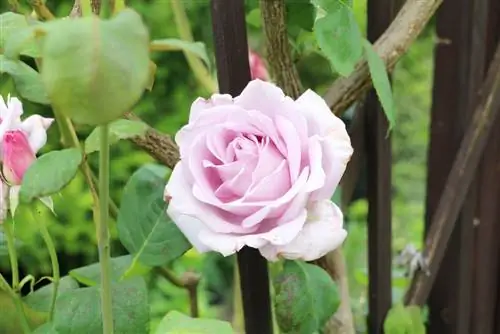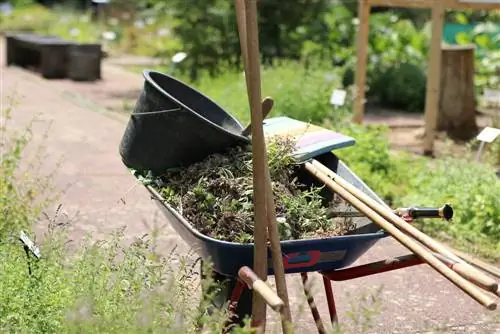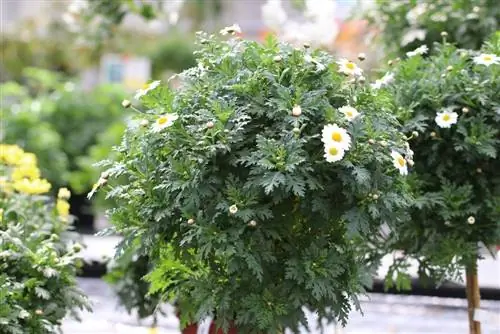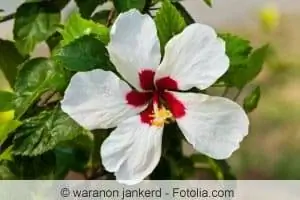- Author admin [email protected].
- Public 2023-12-17 03:39.
- Last modified 2025-01-24 12:45.
As with all other roses, the choice of location is of crucial importance for growth and prosperity. The rose stem does not feel comfortable on constantly moist soil, in the shade of houses or next to vigorous plants in the neighborhood and may constantly have to struggle with diseases.
Caring for rose stems
But even in the right location, there are a few things to consider when caring for it. Particularly important: Make sure that shoots that do not emerge from the grafting area must be removed! Unwanted shoots usually arise directly from the root area or the trunk and these only unnecessarily deprive the plant of water, nutrients and light. As a rule, these wild shoots are easy to recognize due to their changed shape and color.
- In the winter months, the grafting areas must be well protected from frost and also from the winter sun. This is best achieved with a jute sack and special protective fleece available on the market.
- When covering, make sure that air can circulate. Otherwise heat and waterlogging may be produced, which can cause serious damage to the rose stem.
- Depending on growth, the crown should be supported, as a high load threatens to break the rose shoots. If the actual crown becomes too lush, we recommend trimming the crown trunks.
Quick jewelry with rose stems
The last paragraph described the normal case, namely the care of a rose stem that was grown from a grafted rose. Grafted roses are the roses that are usually offered to us in stores, because growing a graft is much quicker than growing a true-root rose. It is therefore advisable to buy such rose stems, which you can sometimes find at a discount store, if you would like to quickly see the desired result in your garden. However, the specialist offers you more choice:
- Dwarf stem roses only form a small stem between 40 and 50 cm. The crown usually consists of a ground cover rose or a dwarf rose, so that these little gems look harmonious in limited terrace beds or planters.
- A half trunk grows to a height of 70 cm. A noble rose, a shrub rose or a ground cover is refined here, which fits well into any perennial planting with medium-sized crowns.
- For standard roses, the same roses are grafted onto a wild rose trunk, which, however, reaches a height of up to 90 cm. With these standard trunks you can create small rose avenues or set specific accents.
- The cascade stem roses grow up to almost one and a half meters high and develop a bushy crown, but are also bred with overhanging shoots, then a rambler rose or a climbing rose is grafted onto the wild stem. Above all, the second form of the cascade rose, also known as the mourning rose, deserves a special position in the garden as an eye-catcher.
- The so-called triple trunks require a lot of space, in which stem roses of different heights are grown from one root, which after a few years look like a single giant flower ball.
You can get all these roses e.g. B. at RosenPark Dräger GmbH & Co. KG in 61231 Bad Nauheim-Steinfurth, also available to order at www.rosenpark-draeger.de.
Long-term planting of standard roses
If you are creating a garden in which you can and want to plan for a long time, you do not necessarily have to rely on refined varieties that only thrive as long as their rootstock feels comfortable. Rather, you could venture into true-root roses, which, like wild roses, can live for ages, even centuries through propagation. They are correspondingly resistant, and that is your advantage if you want to create a permanent avenue of unrooted roses in the garden.
However, you will have to look for a long time for a rose stem that was grown as a true-root rose, because even the grafted stem rose means around three years more work for a rose nursery than a normal rose. Real-root roses are e.g. B. grown in the nursery of Christoph Kruchem from 37136 Waake, which you can reach on the Internet at www.hortensis.de. You could ask them whether they can grow a real-root rose stem for you, or you could get involved in this long-term project yourself and try to grow your own rose stem from a real-root rose.
If it doesn't necessarily have to be a rose stem: The true-root roses are also ideal for the sustainable greening of rose arches and trellises or for creating a rose hedge, and there are some varieties that are just crazy about it Climbing roses to climb trees.
If you already suspect that you will be so enthusiastic about roses that you will sooner or later become a breeder, it is probably not a bad idea to stick to true-root roses. Grafted roses can also be propagated, creating “clones” through further grafting, but this process is too much for most laypeople. With true-root roses, however, you have the choice: you can produce a clone by propagating cuttings or let the rose hips mature to try rose seedlings. It may take a long time, but you will receive something very unique: a genetically varied new rose!






